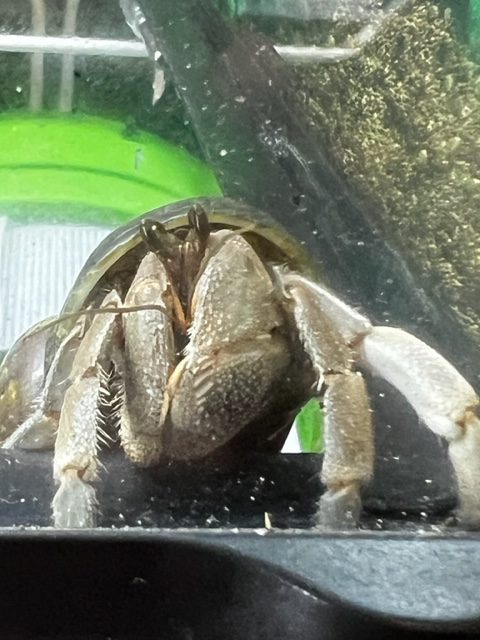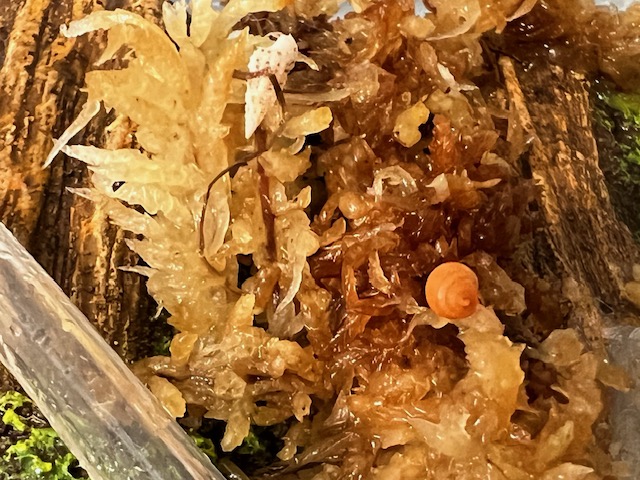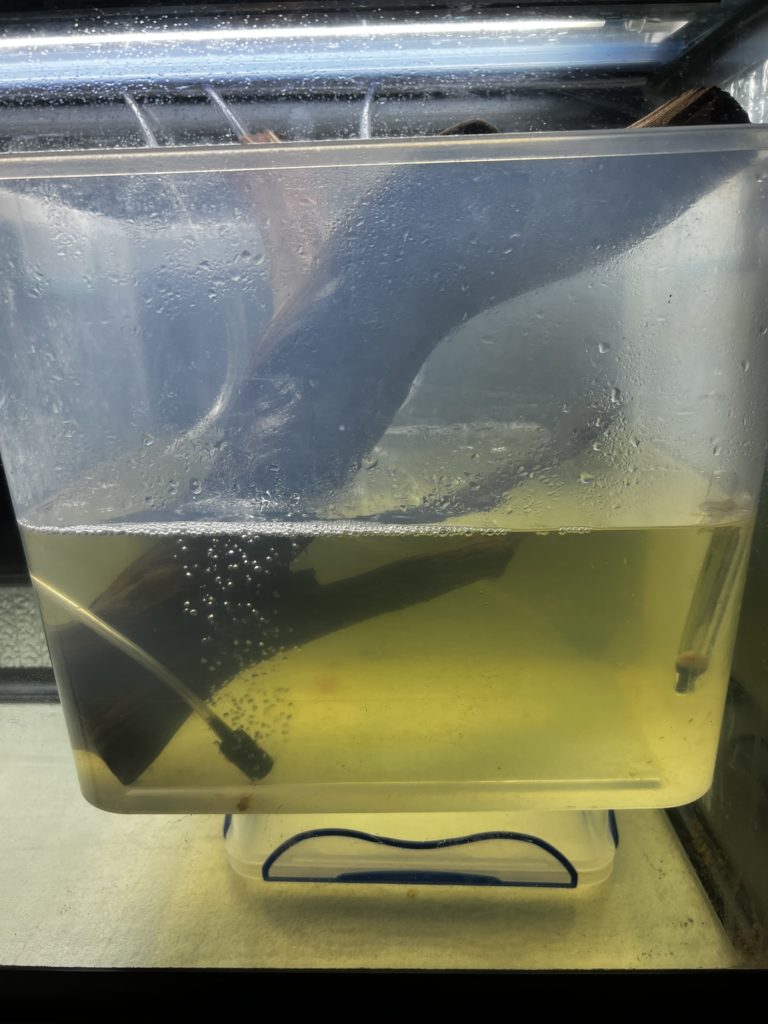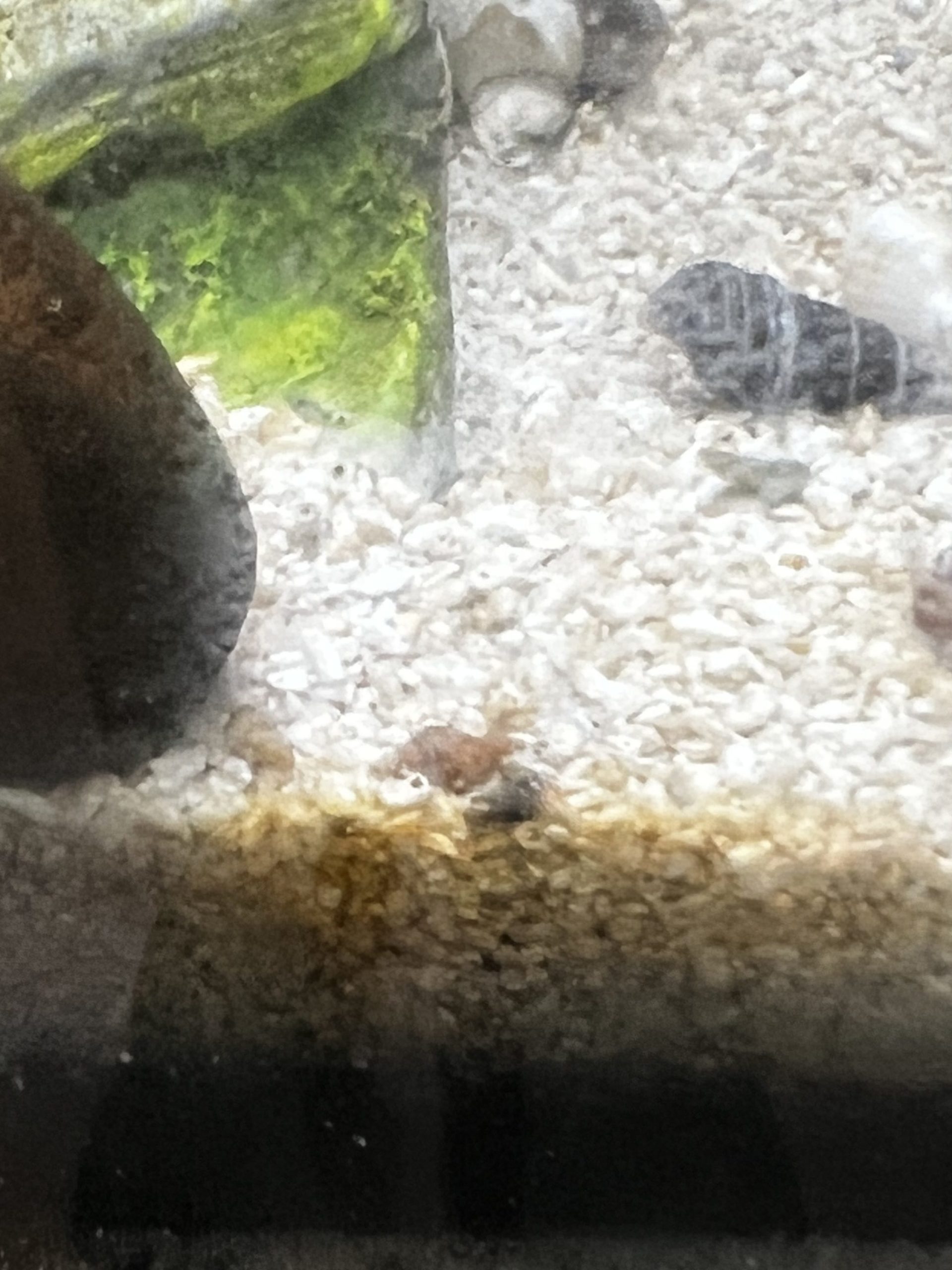
8-1-23, Day One: found a Coenobita rugosus spawning in the 5.5 gallon SW tank in the new 90×90 build (two 90-gallon tanks, connected by a topper, donated by Darcy Madsen of Crab Central Station). This build had only been completed about a week prior. The C. rugosus female who spawned was donated by Stacy Griffith, along with three other C. rugosus of unknown gender, brought to in-person Crab Con to see if we could get her to spawn correctly here (all her previous spawns were incorrectly deposited and no viable zoeae resulted). This female must have arrived carrying eggs and held onto them throughout all the travel and transfers and temporary tanks. She spawned just over two weeks after Crab Con. What a strong and dedicated little breeder! Very excited for the possibilities and grateful for supporters like Stacy and Darcy (both on the Hermit House Board of Directors) who are committed to this process.
C. rugosus is an all-new species for me, though other breeders have brought them to land. They appear smaller than C. clypeatus, but otherwise very similar. Unfortunately, I have a big trip next week that cannot be canceled so Meredith Hass was asked if she would be willing to take them to attempt to raise. She agreed and roughly 2,500 zoeae will be shipped out this afternoon to Meredith by overnight UPS with early arrival. I will keep the stragglers that I am able to find (still swimming around in the big pool) to gather specimens for Dr. Tudge, to see what I can learn from them, and if they will survive while I am away.
8-2-23, Day Two: The shipped, day-old C. rugosus zoeae have arrived safe and sound in North Carolina and will begin their journey with Meredith. I was able to extract ~300 stragglers that are now in my small ten-gallon kreisel from my very first successful attempt in 2018. They appear to be highly light-reactive and are eating chlorella powder and Instant Baby Brine Shrimp quite well. I am keeping them at a salinity of 34PPT and a temperature of 78 degrees Fahrenheit.
8-4-23, Day Four: The very first sheds occurred this morning, just two or three, likely delayed somewhat by the slow start to feeding and care. A few specimens were collected so that we will have some at Stage One. Since they are so tiny and clear at this stage, and I only have the small kreisel, I have been doing targeted feeding outside the kreisel with the variety of awesome zoeae foods provided and carefully packaged by Hermit House breeder Stacy Boltz. Very grateful for her generous donation of time and products. By the way, these foods will be available for breeders through Hermit House for $25 for the full packet of options. Send us a message at our Facebook page or Instagram if you are interested. There are over 15 varieties of foods like rotifers, copepods, spirulina, chlorella, and a wide variety of coral/invertebrate foods. It’s a HUGE savings over buying all the individual foods yourself. Just another service we are providing to help other breeders get a good start.
8-5-23, Day Five: Sheds began today in earnest, so we are entering Stage Two now, very similar to the C. clypeatus timeline. Cleaned Big K (the large kreisel tank that I built last summer) in preparation for being gone. Paula Bolte (HH Board of Directors member and my BFF) has agreed to come by once a day and feed Instant Baby Brine Shrimp while I am away.
8-6-23, Day Six: All C. rugosus zoeae have been moved to Big K. The spray bar will be on a timer, set to activate every eight hours for thirty minutes to exchange the inner and outer waters. (Inner=dirty, outer=filtered.) The light is also on a timer, with 12 hours of light and 12 of darkness. An established saltwater filter was taken from my SW pool in the 120 tank and added to the kreisel to utilize the beneficial bacteria.
8-7-23, Day Seven: Paula came by for an instructional feed at 11am and we left for Galax at noon (attending the Old Fiddler’s Convention). I opted not to add a heater to the kreisel as the temps are projected to be high and my garage stays warm enough. Keeping temps lower than normal should also help with water quality and lower their metabolism to sort of hold them in stasis.
8-8-23: Day Eight: Weather turns rainy and cool, but Paula reports that all are looking good at the morning feeding.
8-9-23, Day Nine: Paula reports at 9am that the water temperature has dropped to 76, so I have her install the water heater, which is preset to 81 degrees. Our trip isn’t going well, so we have decided to return to Blacksburg later today with a stop in Greensboro first to address a recall on our trailer. Started the brine shrimp hatchery overnight so hopefully there will be live BS to feed soon.
8-10-23, Day Ten: Very warm outside, but kept heater on. Brine shrimp had started to hatch this morning and the C. rugosus zoeae (now presume to be at Stage 3) are eating them well! Excellent news.
8-11-23, Day Eleven: Mostly fed live brine shrimp today. All appear to be doing well. Did a small water change, with plans for a full clean tomorrow.
8-12-23, Day Twelve: Did a full clean of Big K and counted 258 survivors. Managed to get a few more specimens for Dr. Tudge, but it is SO HARD to switch from trying to keep every single larvae alive to deliberately sacrificing some. I am constitutionally unfit for specimen collection. The zoeae are getting nice and orange now, with the diet of mostly live brine shrimp. Also feeding Reef Blizzard, chlorella powder, nannochloropsis, and several other coral foods. The zoeae are getting very feisty and quick.
8-13-23, Day Thirteen: Definitely a shed day here, so we are entering Stage 4. Meredith has been tracking sheds with me but did not report seeing any today in her tank.
8-14-23, Day Fourteen: More sheds, no issues here, though Meredith is reporting having issues with what appear to be brown algae sticking to the rostrum and telson, especially. She believes it to be an issue with her water source and has ordered a new filter.
8-15-23, Day Fifteen: Meredith reports seeing heavy losses due to the brown algal growth on her zoeae. Concerned, I examine my own tank and see the start of brown algae developing in the tank (not on the zoeae at this time) so did an exhaustive 100% clean of the inner and outer drums. Feeling better seeing it clean. Examined the zoeae under the microscope just to be sure, and they look excellent.
8-16-23, Day Sixteen: Beginning of Stage 5! So happy to reach that milestone. Lots of sheds today, counted and removed 80+, which is at least a third of the population that I currently have. The zoeae are still smaller than C. clypeatus at this same stage, but all appear healthy, active, and bright orange with very noticeable black dots for their eyes. The eyes of C. rugosus at Stage Five more closely resemble the eyes of C. lila at Stage 2 (their last stage before megalopa) than they do Stage Five C. clypeatus. Since the adult eye structures of C. rugosus are more similar to C. lila, I think this makes sense.
8-22-23, Day Twenty-Two: First megalopa today, 17 total were removed and relocated to the deep transition tank.
8-24-23, Day One (C. clypeatus): Awoke to a C. clypeatus spawn in the saltwater pool. Immediately shipped batches to Meredith Hass and Keith Winkelman as I’m so busy with the C. rugosus. Kept some of the C. clypeatus in the small kreisel. Will eventually move them to Big K with the remaining C. rugosus stage five zoeae.
8-23 & 24-23, Days Twenty-three and Twenty-four: There were 48 megalopa on Day 23 and 14 on Day 24, for a total (so far, three days in) of 79 megalopa. All were moved to a deep transition tank first thing in the morning. Three airstones were place in the tank, delivering moderately vigorous air flow. No sign that the Stage Five zoeae are attacking the brand new megalopa like the PPs do, so that’s great. Very few losses among the surviving zoeae, too. Many still remain in the kreisel eating well and active.
On Day Two (in the transition tank), a large piece of driftwood was added, extending above the water. No shells added yet, perhaps will add a few later tonight or early tomorrow. Temperature is at 80, which is higher than I would like, but my garage is really warm in this hot weather we’re experiencing so I have no control over that. They seem to be doing generally okay at that temperature. (3 are confirmed deceased this morning, but not seeing any obvious cannibalism, which is good.)
They are eating the Hikari Crab Cuisine and the ZooMed Crab and lobster food (both pellets) and to a lesser degree eating the Omega One Super Color Flakes at the surface. I believe they have not touched the Mineral Junkie bite piece that was added to the water. It’s not disintegrating, so I’m leaving it in the transition tank. They have eaten cooked carrot that I added and left overnight. There are also seaweed flakes added (kombu, nori, sea lettuce, wakame, and kelp), but I am unable to confirm if those are being eaten or not. Later today I will offer small pieces of cooked shrimp (would have done that on Day One but forgot to save a shrimp from last week’s dinner–doh!)
8-25-23, Day Twenty-five: 75 megalopa were added to the transition tank this morning–biggest transition day so far (and 154 megalopa total). I think there are only about 30 or so stage 5 left to transition, hopefully tomorrow. (6 megalopa were confirmed deceased today from the previous adds.) I added shells today because a couple of the megalopa that I pulled out during a clean looked like they had already turned into land hermit crabs (more hunched back, tail thicker and curled under, and a darker thorax). It’s been very hot here and I can’t get the water temperature below 80 in my garage. I didn’t have time to see if those few that I thought were already LHCs took shells or not before replacing them. Here’s hoping.
I also put the remaining PP zoeae from yesterday’s spawn into the big kreisel (Big K) with the stage 5 C. rugosus. It’s just easier, and they are such different sizes there’s no concern for getting them mixed up.
8-28-23, Day Twenty-eight: Did a full clean of the transition tank. Lots of sticky, clumps of algae and detritus (food particles, poop waste, etc) at the bottom. I can see them pooping sometimes. It’s just a long thread that extends straight out from their telson. They’re definitely creating lots of waste. Counted roughly 100 C. rugosus megalopa still doing well. They can be sneaky, so there are probably more. Six took shells in front of me while I was cleaning the algae from around them, further proof that it sometimes helps to give them a reason to get into a shell. (I will often “bully” them into shells by shaking the water like the ever-moving ocean would do.) Those six all took either a larval whelk or the very smallest spiral shells so far. That’s in keeping with what I see with the PP megas, too. So far, C. rugosus is acting a lot like C. clypeatus, they’re just taking longer at all the stages. Shipped a batch of the five-day-old C. clypeatus zoeae to Jaimie Heard in Texas.
8-29-23, Day Twenty-nine: Another full clean of the transition tank–so messy! Was worried at first, then counted at least 150 megas still kicking, so I think we’re doing well. Lots more in shells, but still no one exiting the water. Assembled the land tank. Garage was quite cool this morning, so I’ll need to fix the thermostat issue in the transition tank soon. It was also a shed day for the PP larvae, so lots to do there. I’ve kept way too many, even with shipping out to Meredith, Keith, and now Jaimie…mostly because I’m sending 500 or fewer in each shipment so as not to overload folks who are still learning. Probably have 2,500 or so Stage Two PPs now. Getting specimens for Dr. Tudge, too.
8-31-23, Day Thirty-one: Most of the C. rugosus megalopa are in shells now, the majority are in larval whelks, with some small spiral and pink Melissa shells. No nerites are being taken. They are eating well and several of the ones in shells were climbing up the sides of the Tupperware pitcher so I have high hopes they will figure out how to climb the manzanita wood and leave the water when it’s time. If not, and I start to see dead ones tomorrow, I’ll try the shallow transition tank with a bridge and see if that makes a difference. They are eating cooked shrimp, cucumber, and cooked carrot plus the ZooMed and Hikari pellets for crabs and lobster.
9-2-23, Day Thirty-three: Switched the C. rugosus (about 100 confirmed) to the shallower transition tank with the ramp today. Was just feeling that maybe they weren’t exiting the water because of the depth of the water and the wood piece. Did a full clean and the water is now about 4″ deep with three bubblers, the ramp, a piece of coral, sticks of burning bush, and several textured clay ramps to give them lots of exit points.
9-3-23, Day Thirty-four: Did a full clean for C. rugosus, but kept them in the shallower transition tank. Confirmed that there are at least 80 in shells, but probably more because of how well they hide. Garage is very warm, so water is around 81-82 degrees Fahrenheit. Still eating well, a few are flirting with the “shoreline” but none are exiting fully. Hoping for some exits tonight.
9-4-23, Day Thirty-five: Four C. rugosus moved to land today (finally!). 
9-6-23, Day Thirty-seven: Day 37 for the C. rugosus. All are in shells–no more megalopa swimming around as of today. One emerged from the water and was moved to land in his shell this morning (for a total of 5 on land so far) and that one seems to be doing well. I did a (mostly) full clean of the transition tank and there are at least 54 still in shells, crawling around and eating well (probably more, because they do hide in the shells when I’m trying to count them and I only have so much time to wait for them to emerge, lol). I’m not sure why they are still in the water, but trying to let them be crabs. I’m not seeing deaths, so they may just take longer in this final stage. It’s been SO beastly hot in my garage that I worry about temperatures being too high so I replaced the grow light above them with a super bright LED that puts out less heat. The increased light can also help coax them toward land, so we shall see if that changes anything. I am dropping the salinity some, too, to see if it will encourage them to come to land but I am not bullying them–yet.

9-8-23, Day Thirty-nine: Whew. C. rugosus spend a long time in the water in shells….unless I’m doing something wrong, eh? That’s always the rub, isn’t it? Am I seeing natural behavior? Or am I slowly killing them? Gah!
I’ve switched back to the deeper kreisel with the manzanita wood (day before yesterday) since it’s easier for me and didn’t really seem to make a difference having the shallower one with the ramp.
There are 15 on land as of today and they appear to be doing well, though I can’t really monitor them at this stage without creating issues, so I let the ones on land do their thing and hope for the best. Saw one eating apple yesterday. So far that’s all I’ve seen, despite adding coconut, powdered brine shrimp, mysis shrimp, dried seaweed, and banana. There’s also lichen, leaves, and a burning bush stick so they could be eating any of those, of course. Or eating overnight.
MEANWHILE….! There are more than 50 super stubborn buggers still chillin’ in the water of the transition tank. I do think some have sized-up in their shell choices, so this may just be what they do. Stubborn Patience: it’s the crab raiser’s friend…..sometimes. LOL
I’ve officially gone off my rocker today. Been staring at miniature creatures too long, clearly, while trying to anticipate their every need.
Please. Send. Help.
9-10-23, Day Forty-one: The C. rugosus in shells are finally starting to come out of the water on their own and most seem to be tolerating land well enough. (Hard to know/say for sure, but not seeing any issues generally is a good thing. They don’t tend to hide when they have issues–they come to the water dish or open space.) As of today, 33 are on land with maybe 20 more still in the water. Things have been wearing me down. I know I’m getting fatigued with the process when little issues like tangled cords or airline tubing that keeps kinking make me so annoyed. I’ve said, “Really??” and “Come on!” probably more times these last few days than I do in a whole month.
Also being clumsy is another sign and I’ve been plenty clumsy. To keep from possibly ruining everything I’ve been doing with an episode of clumsiness/fatigue I’ve had to streamline, so the C. perlatus (Day 6) are now in with the C. clypeatus (Day 16). We’ll see how it goes. Still no sign that the straws are eating the live brine shrimp, so we’ll see how they do in Big K. (My large kreisel.)
There was one lone C. clypeatus megalopa today, but I expect a flood of them to start tomorrow, so the transition tank will also soon have combined species, too (C. clypeaptus with C. rugosus). I just can’t keep everything separate and keep all those tanks and water changes and bubblers going. I’ll have to trust that I can tell them apart once they are old enough to adopt out. By the way, this is really fast for C. clypeatus megalopa, but my garage has been insanely hot for the past week and I had no way to cool down the water, so they developed quickly. Historically, that seems to make them not quite as strong as megalopa, but we’ll just have to see, won’t we?
10-2-23, Day Sixty-two (I think): 30 surviving C. rugosus were moved from the temporary land tank into the 20-tall baby tank which they will share with the year-old C. lilas that are still left in there. Since I only kept about 300 zoeae, that gives me a 10% survival rate from zoeae to land hermit crab, which is my best survival ratio yet. I think it’s mostly because the C. rugosus are a very sturdy species and also because I didn’t rush them to land. They took their time, which was sometimes frustrating, but yielded a great result in the end.

10-7-23: It’s now day thirty-two for the C. perlatus spawn and I have only two left but they are both in shells yet refusing to leave the water (like last year). I can’t bear to keep them alive for weeks in the transition tank, target feeding them every day and agonizing over them, so I’ve decided to try adding them to the cycled saltwater tank that is already inside my 90-gallon twin exotics tank. (That’s where they were initially spawned.) There are two small aquatic hermits in there already, along with copepods, amphipods, and some other critters I don’t love, like fire worms (can’t seem to eradicate them), but we will just see how they do. One is in a very tiny but very black shell, so I should be able to track that one’s progress, at least. This will be yet another one of those experiments borne out of sheer exhaustion. Fingers crossed.
10-8-23: I just saw one of the tiny C. perlatus in the cycled tank with sand! He’s going strong and looking really good. Still SUPER tiny, but alive!! This may be the answer for straws once they get to megalopa! I fed him a crab and lobster pellet and the aquatic hermits immediately rushed in and took over, which alarmed me at first, but hermit crabs are notoriously messy eaters, so there will be plenty of tiny pieces leftover for that little guy. They both walked all over him (a red-legged and a blue-legged), and he was fine. I’m ridiculously hopeful that this could be the answer for those stubborn straw megas. Maybe they don’t come out of the water right away like other species because they have to grow more first. That very teeny tiny black shell in the center, right up next to the glass (in the image below) is the C. perlatus in his shell. So, so small.

10-13-23: The little guy in the tiny black shell is still alive. He hasn’t sized up, shell-wise, but is still eating well and moving around–with more ease and confidence each day. This is a full week now that he’s been alive and eating in the 5.5 gallon saltwater tank inside my exotics tank. It’s been a telling experiment, even if he ultimately doesn’t make it. The remaining straw zoeae (from a second spawn) that I still have (just a handful) are starting to make megalopa. I’ve had a series of disappointments this past week, and it’s all I can do to keep their water changed and feed them the minimum. So I am feeding a liquid solution Macrovore, Instant Baby Brine Shrimp first thing in the morning, and an algae mix from Algae Research Supply. It contains four different microalgae, but one of them is a brown algae, so I don’t recommend it for filtered kreisels, but for my ten gallon one with a two-gallon drum (that I’m using now) it works okay because I exchange the water 100% once a day and it’s only the inner drum. That’s all I can manage at this time–no targeted feeding, no extra foods. A few have been able to get to megalopa stage with just that minimal combination of nutrients. It’s not an ideal diet, but sometimes we make important advances when we reach the end of our rope and can only do what we can manage. Good luck little guy!